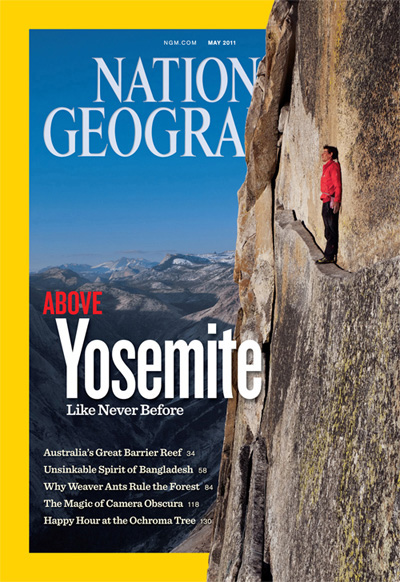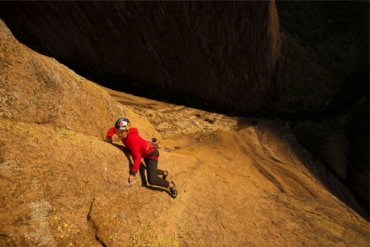In the outdoors world, Jimmy Chin, a 37-year-old photographer based in Victor, Idaho, wears two elite hats: As a member of the exclusive North Face Athlete Team he is a veteran climber, skier, and undisputed all-around mountain man. He’s also one of the world’s most prolific expedition and adventure photographers, having traveled to all corners of the globe on dozens of big expeditions over the past 15 years. But even professionals like Chin at the top of the game have aspirations to keep pushing “to the next level,” and this month Chin reached one of his longtime goals: The cover of National Geographic Magazine. The May 2011 cover of National Geographic, on newsstands this week, features Chin’s dramatic photograph of climber Alex Honnold rope-less and high on Yosemite’s Half Dome formation. (Online, the magazine has a full photographic feature by Chin and other shooters in Yosemite, “Daring. Defiant. Free.”) We caught up with Chin for a chat on his experience in Yosemite with Honnold as well as what it feels like to be a part of National Geographic’s rarefied photographic club. —Stephen Regenold

1. After your cover photo was published this month, you wrote one thing on a Facebook post: “A life long dream… realized.” Tell us more!
I grew up looking through National Geographic Magazines. I never thought I would be a photographer growing up, but I fell into it while I was living as a climbing bum in Yosemite. I was totally self taught. Now I’ve been shooting for almost 15 years. I think any photographer aspires to shoot a cover story for National Geographic. Also, one of my inspirations was Galen Rowell. He was also a Yosemite climber and his first cover for National Geographic was the June 1978 issue of the magazine. The photograph showed a climber on the northwest face of Half Dome. My cover shot shows Alex Honnold on the northwest face of Half Dome as well.
2. Was it nerve-wracking to photograph Honnold on that ledge?
This spot for Alex is actually fairly comfortable for him. The climbing above and below this section are actually the really intense spots. I was actually fairly relaxed shooting him here compared to how I felt shooting one of the other sections below this point. There is a three page fold-out of the other image where he is climbing a steep section of the route. You can see it falls away pretty dramatically there. One wrong move and he would have fallen a couple thousand feet.

3. What were the logistics involved to get that shot?
There are two ways to shoot in Yosemite: You can climb from the bottom up with the climbers or hike up the back of a formation and rappel in from the top of the cliff. I did both on this assignment. For this shot of Honnold, I climbed up the back of Half Dome and rappelled in. I’ve climbed the route probably about 10 times, so I know it well. That was really helpful because I knew what sections I wanted to shoot and how to get there. It’s deceptively hard to navigate yourself around on these big faces. There are a lot of features on the walls that don’t look very big from the ground but if you are off even by a little bit as you rappel in, you could be totally blocked from ever seeing or finding the climbers you’re hoping to shoot by a huge rock pillar.
4. What kind of camera gear did you use?
I shot most of the assignment on the Nikon D700 and used Nikkor lenses.
5. What about other outdoors/climbing equipment? Anything special?
I have been working with the North Face for ten years now as an athlete on their athlete team. So, I had all the camping gear and apparel necessary to do the job. We had to be ready at any time for anything from rain to snow to serious baking in the sun on the walls. We experienced a lot of different conditions and temperatures during the shoot. Besides the various insulated jackets, down jackets, lightweight wind jackets or waterproof jackets, different temperature sleeping bags, tents, different sized backpacks, specialized climbing packs, etc., we needed a lot of climbing equipment. We were always moving a ton of climbing gear and camera equipment around to each shoot location and, of course, most of the locations were in the middle of a massive rock wall. We used thousands of feet of rope.
6. How long did you spend photographing in Yosemite Valley for this assignment?
I spent about a month in the spring and a month in the fall to shoot the assignment. With this kind of shoot, you spend a lot more time planning, dealing with logistics, and moving gear than you do shooting. I probably only shot one-third of the days I was there.

7. Approximately how many photos did you submit to the National Geographic editors, and how many ended up in print?
Unlike any other magazine I have ever worked with, National Geographic looks at everything you shoot. I mean everything. I was really self conscious at first because I had always had the opportunity to edit before an editor saw my photos. I got over it eventually, and I worked with an amazing photo editor, Sadie Quarrier. She was really helpful and we got through a solid 25,000 images — they are very thorough over there and don’t want to miss anything! I definitely would have missed one of the shots that ended up in the magazine. In fact, I did miss it. Sadie found it and I never would have caught it.
8. Any general advice you give to aspiring adventure photojournalists?
I always tell people who are starting to shoot something they are passionate about and know well. This gives them access to a particular world that they are comfortable with and understand and they can focus on the shooting. I loved climbing. I knew a lot of climbers. I read a lot of climbing magazines. I started my career shooting climbing, learned a lot about shooting and built my portfolio there. I was able to apply things I learned shooting climbing to all kinds of other areas of shooting. Another thing: I always tell people to look at a lot of different work, commercial, fashion, war, documentary. I think it is a good exercise to pay attention to why you like a photograph, think about how it moves you, why it moves you. How was it shot? What did the photographer have to do in order to get the image? And, finally, get out and shoot a lot. Share your work. Have people critique your work. Most of all, have fun.

9. What is one thing you wish someone would’ve told you when you were getting your start?
I’m not sure about that one. I do think a lot of people think that being a photographer is just about taking pictures. If you want a career in it, you also have to pay attention to the business end of the job. Don’t undervalue your work. Work hard, be committed and the rest will come.
10. What’s on your calendar for this spring and summer?
I have a few shoots lined up for the year. I’ve been trying to find the balance between being a full-time athlete, being a photographer, and director/producer for Camp 4, the production company I started last year. I have a few speaking engagements during the year as well. The next one is at the National Geographic HQ on June 2nd in D.C. I leave for a ski-mountaineering shoot on Denali right after that, then I’m home for a couple months to train for a climbing expedition to the Sharksfin on Mount Meru in northern India later in the summer. I will be shooting on the Meru trip as well.
See more of Chin’s Yosemite photos online in the National Geographic photo feature “Daring. Defiant. Free.” A version of this post ran originally on Gear Junkie’s blog on VentureThere.com, a USA Today property.






